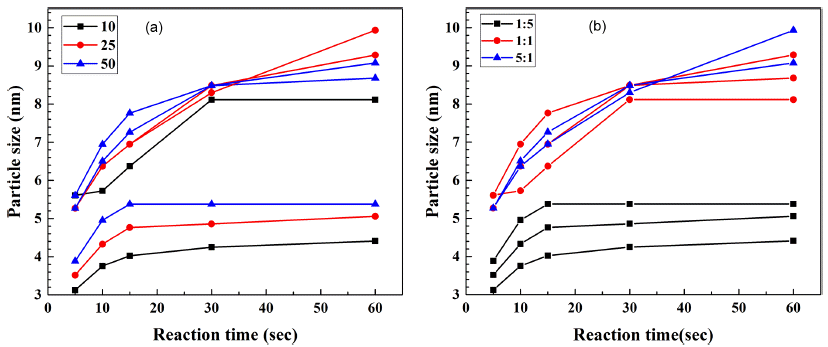- [Korean]
- Synthesis and analysis CdSe Quantum dot with a Microfluidic Reactor Using a Combinatorial Synthesis System
-
Myung Hwan Hong, Duk-Hee Lee, Lee-Seung Kang, Chan Gi Lee, Bum-Sung Kim, Nam-Hoon Kim
-
J Korean Powder Metall Inst. 2016;23(2):143-148. Published online April 1, 2016
-
DOI: https://doi.org/10.4150/KPMI.2016.23.2.143
-
-
 Abstract Abstract
 PDF PDF
A microfluidic reactor with computer-controlled programmable isocratic pumps and online detectors is employed as a combinatorial synthesis system to synthesize and analyze materials for fabricating CdSe quantum dots for various applications. Four reaction condition parameters, namely, the reaction temperature, reaction time, Cd/Se compositional ratio, and precursor concentration, are combined in synthesis condition sets, and the size of the synthesized CdSe quantum dots is determined for each condition. The average time corresponding to each reaction condition for obtaining the ultraviolet–visible absorbance and photoluminescence spectra is approximately 10 min. Using the data from the combinatorial synthesis system, the effects of the reaction conditions on the synthesized CdSe quantum dots are determined. Further, the data is used to determine the relationships between the reaction conditions and the CdSe particle size. This method should aid in determining and selecting the optimal conditions for synthesizing nanoparticles for diverse applications.
- [Korean]
- Fabrication of Sn and SnO2 Nanopowders by Low-Temperature Phase Transformation Method
-
Kun-Jae Lee, Yeon-Jun Joo, Yong-Dae So, Nam-Hoon Kim, Jai-Sung Lee, Yong-Ho Choa
-
J Korean Powder Metall Inst. 2006;13(1):46-51.
-
DOI: https://doi.org/10.4150/KPMI.2006.13.1.046
-
-
 Abstract Abstract
 PDF PDF
- Through the volume change of Sn in a low-temperature phase transformation, the Sn nanopowder with high, purity, was fabricated by an economic and eco-friendly process. The fine cracks were spontaneously generated. in, Sn ingot, which was reduced to powders in the repetition of phase transformation. The Sn nanopowder with 50 run in size was obtained by the 24th repetitions of phase transformation by low-temperature and ultrasonic treatments. Also, the SnO_2 powder was fabricated by the oxidation of the produced Sn powder to the ingot and milled by the ultrasonic milling method. The SnO_2 nanopowder of 20 nm in size was fabricated after the milling for 180 h.
|



